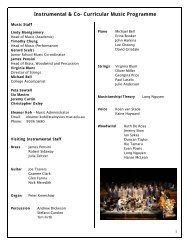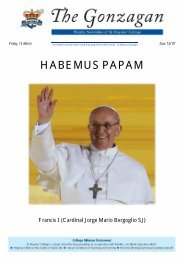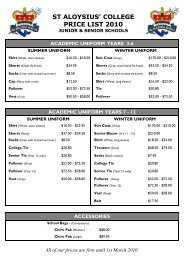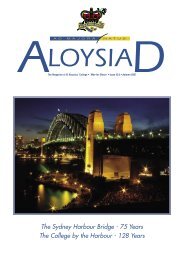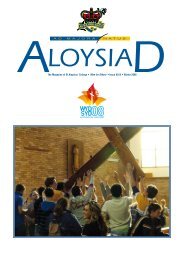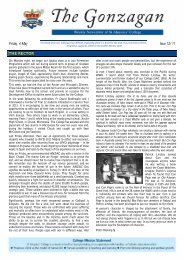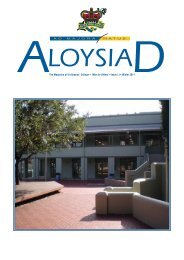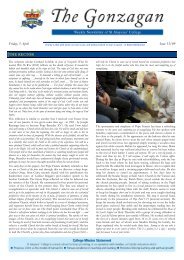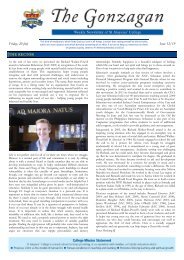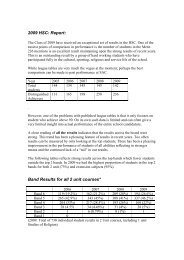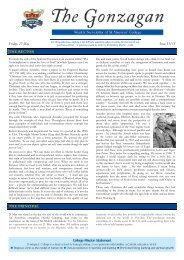Friday, 5 August Issue 11/21 THE RECTOR - St Aloysius
Friday, 5 August Issue 11/21 THE RECTOR - St Aloysius
Friday, 5 August Issue 11/21 THE RECTOR - St Aloysius
You also want an ePaper? Increase the reach of your titles
YUMPU automatically turns print PDFs into web optimized ePapers that Google loves.
<strong>THE</strong> PRINCIPAL<br />
On 6 <strong>August</strong>, the world marks the anniversary of the dropping of the<br />
atomic bomb on Hiroshima. Three days later, a second bomb was<br />
dropped on Nagasaki. More than two hundred thousand deaths<br />
would result from those two bombs. Tragically, neither of the two<br />
attacks rate as the most horrendous events of the war in terms of<br />
civilian casualties – the siege of Leningrad, the capture of Nanking,<br />
not to mention the Holocaust itself, immediately come to mind. Yet<br />
in our imagination, the dropping of the A-bombs marked a new stage<br />
in warfare. We are confronted with the juxtaposition of the amazing<br />
extent to which we human beings are able to achieve technologically<br />
with our corresponding capability to inflict horror on our fellow<br />
human beings. This remains an enduring challenge for humankind.<br />
Peace Park memorial at Hiroshima<br />
Albert Einstein wrote in 1946 of his fear about the way science and<br />
reason could be used to increase our capacity to destroy: “the unleashed<br />
power of the atom has changed everything except our modes of thinking and we<br />
thus drift toward unparalleled catastrophe”. It is good to pause this week to<br />
remember all those who suffer in war, to recommit ourselves to be<br />
peace-makers and to work for a more just world in which violence is<br />
overcome. The dropping of the A-bomb is also a reminder that the<br />
progress in knowledge is not a panacea for the human condition and<br />
that the moral and spiritual dimension of the human needs constant<br />
nourishment.<br />
Coincidently, 6 <strong>August</strong> also marks the feast of the Transfiguration,<br />
where Jesus allowed His disciples a glimpse of himself as their<br />
transfigured Lord, as one whose humanity is united intimately and<br />
fully to His divinity. The most fundamental question in Christian<br />
faith is ‘who is this person?’. Ultimately most Christian theology,<br />
spirituality and worship comes back to the response that we give to<br />
this question. More personally, our faith responses to the question<br />
determines the claim that Jesus has on us and the nature of the<br />
relationship we are invited to have with Him.<br />
In this ancient feast, we also celebrate something of the transfiguring<br />
power of God, a God at work in our human story, both respecting<br />
our integrity and freedom as human beings, while bringing new<br />
possibilities to us, even to overcoming death itself. This ‘good news’<br />
stands in stark contrast to the temptation to despair, which events<br />
such as Hiroshima can place before us. We are caught up in the<br />
mystery of God. Though not an orthodox believer in God, Albert<br />
Einstein himself, wrote of the sense of mystery in life:<br />
“The most beautiful thing we can experience is the mysterious. It is the source<br />
of all true art and science. He to whom the emotion is a stranger, who can no<br />
longer pause to wonder and stand rapt in awe, is as good as dead: his eyes<br />
are closed. This insight into the mystery of life, coupled though it be with fear,<br />
has given rise to religion. To know that what is impenetrable to us really<br />
exists, manifesting itself as the highest wisdom and the most radiant beauty<br />
which our dull faculties can comprehend only in their most primitive forms –<br />
this knowledge, this feeling, is the centre of all religiousness. In this sense, and<br />
in this sense only, I belong in the ranks of a devoutly religious man”.<br />
Our great religious feasts are not<br />
only ritual and memorials of past<br />
events, but have an on-going role<br />
in revealing something of the<br />
fundamentals of the human story<br />
and of God’s relationship to that<br />
story. One of those fundamentals is<br />
Christian hope. We are believers in<br />
redeeming love, namely, that no<br />
person and no situation are beyond<br />
the power of God’s love. We are<br />
realists in acknowledging the<br />
propensity within the human to<br />
inflict pain and sorrow, and thus the<br />
reality of evil, but we also assert that humankind is in the image and<br />
likeness of God, and that our capacity to love and to be loved<br />
underpins human existence.<br />
We welcome to the College two staff (Mr Masahiko Hamasaki and<br />
Mr Takaharu Iwasaki.) and fourteen students from Kaisei High<br />
School in Nagasaki, Japan. The school has had a real cosmopolitan<br />
feel over these last weeks with groups of exchange students from<br />
Poland, Italy and Japan with us, as well as individual exchange<br />
students from France and Italy. As always we have relied on the<br />
generosity of many families to host these visitors.<br />
A highlight of the school social calendar is the Year 9 Ballroom<br />
Dancing with Loreto. The boys, and girls, were in high spirits and<br />
some considerable talent was shown. At the end of the night, the top<br />
four pairs were chosen by popular acclamation: Nick Lonergan,<br />
John-Paul Field, Charlie Hill and Tom Wells, and their partners.<br />
Congratulations to our Year 10 Drama students who competed at the<br />
<strong>St</strong>ate Shakespeare Festival. In the solo section, Felix Lush came<br />
second, as also did our Mash Up group of Hugh Logan, Tom<br />
Lawson, James Mullan and Ryan Greves.<br />
Congratulations to our Year 10 CSDA Debaters who were runnersup<br />
to Santa Sabina in the grand final of that competition.<br />
In the School Sport Australia Swimming championships in<br />
Melbourne, the Junior School’s Lucas Anderson (Year 6) had the<br />
honour of being the Junior Boys’ captain in the NSW team. Lucas<br />
took silver in the 100m backstroke and bronze in the 200m individual<br />
medley and 50m Backstroke. Matthew Jepson (Year <strong>11</strong>) was also<br />
competing at the championships and won gold in the 200m Freestyle<br />
and the 400m freestyle.<br />
In Saturday sport, our First XV recorded an excellent win (28-8) over<br />
Cranbrook, while the First XI went down (1-2) in a very tight<br />
contest. The Firsts Tennis side had a clean sweep to stay well in the<br />
hunt for the CAS title as did our Firsts’ Debaters. The Firsts<br />
Volleyballers went down to Grammar. Many of the younger teams<br />
also had excellent results. The 7Ds had a great 2-1 win in front of<br />
their enthusiastic supporters, while the supporters were perhaps even<br />
more enthusiastic as the 13As overturned the first round with a<br />
magnificent victory. The comeback story, worthy of the Rabbitohs,<br />
was the 10As – down 0-3 at half time, a different team emerged in<br />
the second half to draw level at 3-3. In Cross country, William<br />
Austin-Cray (Year 12) was fifth in the CAS in the Seniors, and the<br />
U16s’ team was second.<br />
Congratulations to our Junior Secondary Chess team which has<br />
reached the Metropolitan North Regional finals of NSW Secondary<br />
Schools competition. Our Intermediate and Senior teams were both<br />
runners-up in their qualifying groups.<br />
Finally, please keep in your thoughts and prayers our Year 12<br />
students who commence their HSC Trial Examinations on Monday.<br />
Our Drama and Music students have already completed their HSC<br />
Trial Performances.<br />
Chris Middleton SJ<br />
2



